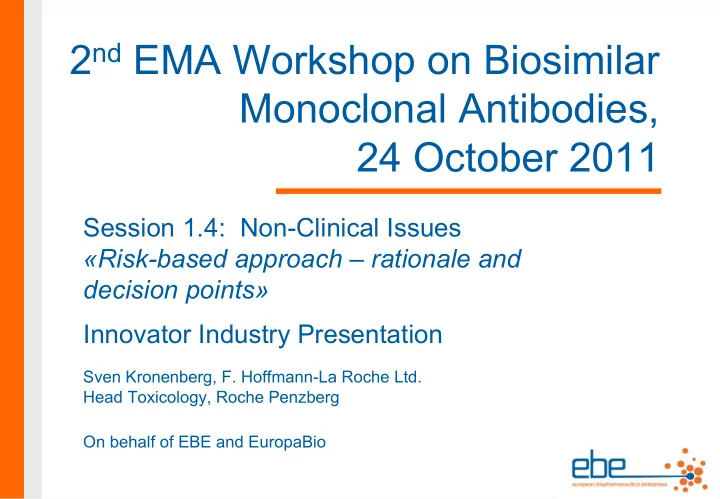

2 nd EMA Workshop on Biosimilar Monoclonal Antibodies, 24 October 2011 Session 1.4: Non-Clinical Issues «Risk-based approach – rationale and decision points» Innovator Industry Presentation Sven Kronenberg, F. Hoffmann-La Roche Ltd. Head Toxicology, Roche Penzberg On behalf of EBE and EuropaBio
Risk-based approach EBE welcomes opportunity to comment on this guideline. A ‘risk-based approach’ is generally supported, but should be clarified for two major aspects: The current ‘risk-based approach’ allows to fully rely on in-vitro similarity prior to first human safety/efficacy trials However, innovator industry considers one animal study with the biosimilar candidate prior to FIM to verify that no unexpected findings (PK/PD/Safety) are observed (slide 3) The extent of in-vivo testing should be based on level of concern (slide 4 & 5) Clarification is needed on... Selection and qualification criteria for analytical and in-vitro assays Additional factors important for the in-vivo nonclinical strategy (slide 5) 2
Risk-based approach – Animal Testing Innovator industry recommends an animal PK/PD/safety study should be considered prior to clinical trials of a biosimilar mAb until sufficient data on biosimilars is accumulated To safeguard human subjects prior to FIM safety/efficacy trials (mirrors existing EMA biosimilar framework) for potential in-vivo findings Endpoints could be combined in one animal study (eg, PK/PD with safety evaluation) depending on level of concern In certain cases the sponsor may consider progressing into FIM without an in-vivo study based on sound scientific justification and careful risk assessment Once more thorough experience with classes of mAb biosimilars has been obtained, requirements for in-vivo animal testing may be revisited and adjusted 3
Risk-based approach – Minimum vs Extended FIM-enabling Animal Study Proposed minimum vs extended animal testing: The extent of in-vivo testing should be based on level of concern (Risk-based approach) Minimum Design* Extended FIM-enabling Design 2 dose levels/cpd 1-2 dose level(s)/cpd One gender Both genders No recovery groups Recovery groups Possible shorter treatment duration Treatment between 4 and 13 wks Reference product – case-by-case Reference product PK/PD/toxicity evaluation *) e.g. if no analytical/in vitro flags, no concern in healthy animals with originator mAb Even if not pharmacologically relevant, the rodent may be considered an alternative test species in some cases (eg, for PK) In-vivo testing should evaluate if important PK/PD/safety findings occur. Testing for differences between biosimilar and reference product can be case-by-case A scientific rationale for the Risk-based approach on animal testing should be provided (eg, justification for gender, dose levels, duration, recovery) 4
Risk-based approach – Clarification on in- vitro criteria and factors for in-vivo strategy Clarification is needed on... Selection and qualification criteria for analytical and in-vitro assays How to determine the (minimal) acceptable level of difference, range of variability etc. Choice of assay defines/limits quality of data (assay variability may depend on cellular system used, e.g. ADCC assay with PBMCs vs cell lines) Qualification of reagents used to characterize potency, identity, etc. topics for revision of EMA biosimilar quality guideline? Additional «factors important for the in-vivo nonclinical strategy = step 2» Nature and range of critical differences in quality attributes (eg, any vs some glycosylation differences and/or changes leading to differences in charge) Where data from analytical and in-vitro assays or the assays themselves are considered limited or inadequate (ie, selection and quality of tests need to be defined – see above) Where an originator mAb mediates effects in-vivo that are not yet fully elucidated Where there is a narrow safety margin with originator Key safety attributes that can only be characterized/compared in nonclinical models (eg, evaluable only by histology), or rationale for why they are deferred to clinical testing. 5
Risk-based approach - Summary The current ‘risk-based approach’ allows to fully rely on in-vitro comparability prior to a first human safety/efficacy trial However, innovator industry recommends one animal study with the biosimilar candidate prior to FIM to verify that no unexpected findings (PK/PD/Safety) are observed The extent of in-vivo testing should be based on level of concern Clarification is needed on... Selection and qualification criteria for analytical and in-vitro assays Additional factors important for the in-vivo nonclinical strategy 6
Recommend
More recommend